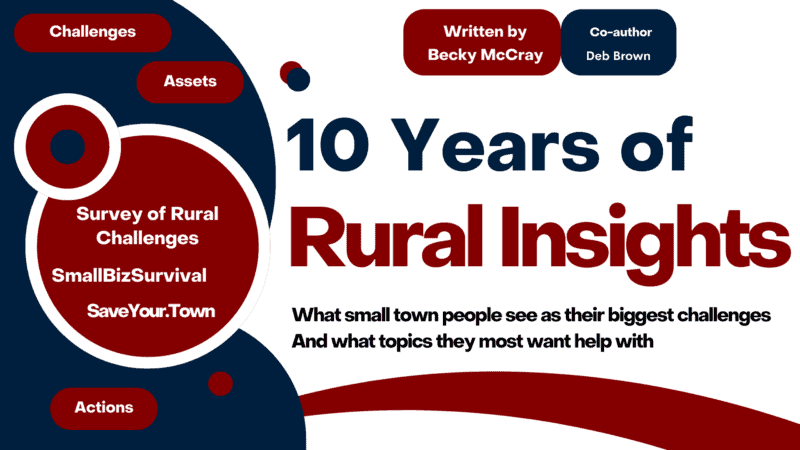Survey of Rural Challenges 2015 – 2025 results
Download the PDF report Executive Summary The Survey of Rural Challenges asks rural people to share their ground-level insight into the challenges they face and the assets they can use. This report analyzes over 2200 responses from communities across the US and Canada from 2015 to 2024. The responses show what’s changing and what isn’t […]
Download the PDF report
Executive Summary
The Survey of Rural Challenges asks rural people to share their ground-level insight into the challenges they face and the assets they can use. This report analyzes over 2200 responses from communities across the US and Canada from 2015 to 2024. The responses show what’s changing and what isn’t in small towns and rural places from the point of view of their own people.
- Persistent challenges: Youth out-migration, downtown decline, workforce shortages and struggles with local business marketing continue to challenge rural communities.
- Fast-moving concerns: The housing crisis, lack of adequate childcare and lack of support for small businesses have increased as significant rural challenges in recent years.
- Slow-building challenges: Over time, the lack of volunteers, the pressure from online competition on local businesses, and the lack of usable commercial buildings have risen to greater importance.
- Appreciating assets: The strength of rural communities to address their challenges comes from significant assets, including natural resources, strong social bonds, a spirit of entrepreneurship, a small but dedicated workforce and action on broadband access.
- Demographic shifts: Besides basic population numbers in their communities, rural people noted differences in ages, professions, education and more.
- The external view: Much of this nuance is lost in the external understanding of rural challenges and assets in the media, government, organizations and agencies.
The primary conclusion is that although good ideas are stifled by conflict, negativity and old way thinking, communities that are open to new ideas can thrive. Agencies, organizations, media and policy makers can use these insights to improve how they serve rural people.
Survey of Rural Challenges Ten-year Trends
The Survey of Rural Challenges collected input online from rural and small town people. The questions offered multiple-choice options for challenges and open-ended responses about assets, community makeup and anything else they wanted to share about their communities and businesses. The survey was opened for limited time periods, with results shared in 2015, 2017, 2019, 2021, 2023 and 2024. This data over time provides a view of the changes in rural communities.
Authors Becky McCray and Deb Brown analyzed the complete set of over 2200 responses, identifying challenges that have persisted, new fast-moving concerns and some slow building challenges that have risen over time. They also identified rural assets, the internal view of demographic shifts in rural communities, and insight into how the external view differs.
The primary insight: Good ideas are stifled by conflict, negativity and old way thinking, and towns that are open to new ideas can thrive.
In all rounds of the survey, open-ended responses were dominated by all kinds of negativity, the stifling influence of the old guard in leadership, and people who tried to slow down any changes. Responses mentioned leaders not moving forward, not acting on suggestions or new ideas, people with a “poor us” attitude, and communities breaking into factions for and against change. Personal agendas, local organizations that don’t work together and infighting hold communities back.
In 2019, one response said:
The old guard had a lot of experience – good & bad – and with new ideas tended to say “we tried something like that once…” and instead of taking what didn’t work & learning from it, crossed it off the list of things to try at all
Facing apathy, resistance to new ideas and focusing too much on the past all inhibit how willing people say they are to keep taking action. People’s initiative becomes “a strength hobbled by a problem,” one response from 2023 said.






